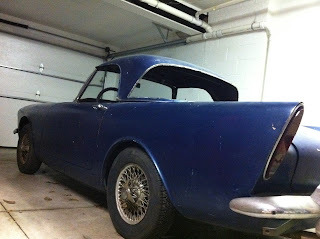So I’ve spent the past couple of months measuring, thinking, and, eventually, cutting a 327-sized hole in this li’l blue car. The best thing I’ve had going for me is that Carroll Shelby did something very similar almost 50 years ago, but he had a team, corporate backing, funding, and experience on his side – I’ve got a marker and a plasma cutter. Oh wait, and a tape measure. All three have been applied liberally.
But before I begin, let’s first go back to the beginning...
[Around mid-February 2012, in my garage, planning stuff:]
...Although not originally designed for a beefy V8 or a bulletproof 5-speed trans, the dimensions are surprisingly not too far from workable. The initial measurements are looking good; packing in the radiator, motor, and transmission will be tricky, but very doable. Line up tight, boys! It’s going to be a nuts-to-butts situation.
The foreseeable issues that I’m prepared to face are:
Front-to-rear weight distribution.
To offset the additional engine weight and to get the best possible handling, I need to position the motor as far back without blocking access to valve covers or spark plugs. I’d like it to look good, too – not pushed all up into the firewall.
Ground clearance.
Seems to be accommodating for a nice, low (but not too low) engine position to get that center of gravity down.
Distributor.
Since I’m using a Chevy engine, the distributor is in the back of the motor instead of the front like a Ford/Tiger block. It's going to need some room.
Exhaust headers.
Measurements indicate a tight fit between the frame rails and the engine - like an inch or so on each side.
Throttle/Brake/Clutch pedals.
Uproot and relocate – the new transmission tunnel’s taking over your prime real estate.
Steering and front suspension.
The Rube Goldberg-looking, out-dated Alpine steering linkage won’t work with the new engine in the way. And I’m sure I can find something better than that ox yoke of a front crossmember.
Rear suspension.
The rear will need to be replaced as well. With some new springs and trac bars, I think the housing might be strong enough, but the diff gears and axles? The horsepowers and torques I’m expecting will tear them up. And quick.
It's now time to fire up the plasma cutter. So is it ‘measure twice, cut once’?...
[Present day:]
...More like ‘measure seventeen times, cut repeatedly'. After a few cardboard mockups, test fittings, and outright trickery, the engine is in the car, resting on temporary mounts. Here are some progression shots for you:
 |
| Stock Engine Hole |
 |
| What it Takes to Fit a V8 in There |
 |
| Ta-Da |
 |
| Pre-Op |
 |
| Per-Op |
 |
| Post-Op |
 |
| Not Yet |
 |
| Getting There |
 |
| That's the Ticket |
Commenting on the foreseen issues above:
Weight Distro: The engine is in the best position it can be in. There should be just enough room for the radiator up front, and the gear shift position is very close to the stock location. The support bars even still fit in there - Cha-ching! I won’t know the F/R distro numbers until later, but (since this is such a light car) I can add weight to the rear if the numbers are crazy off. (I'm also using aluminum heads and intake manifold, saving about 100 pounds on the engine up front.)
Ground: The whole engine/trans assembly is just a couple of inches above the bottom of the frame (like it’s meant to be in there). A cowl/scoop is needed for hood clearance – I’m cool with that.
 |
| Clearance: Good! |
Distributor: I needed to bust into the heater core compartment a little to make room for the distributor. The heater will still work, as will the vent controls, but I’ll need to make a trap door on inside the car to be able to install/access the heater core.
 |
| Minimal Modifications for Distributor |
Exhaust: TBD. Room will need to be made, I just need to finalize my decision on which headers or exhaust manifolds to go with. Cut and weld, my friend, cut and weld.
Pedals: Still need to finalize and install them, but the mock ups are looking promising – brake and clutch will be shoved over to the left a little and the throttle will sit under the steering column.
Suspension: It’s still way too early to discuss anything other than speculation at this time, but it looks like C4 Corvette front and rear suspensions will fit in there nicely with a little narrowing (like an inch or two). I’ll crack those nuts after I have the exhaust and steering straight.
And some fun stories and lessons learned:
- With the
limited-sized hood hole to work with, the drivetrain was not going in
from above - I needed to jack the car up, slide the engine/trans under,
lower the car down, and pull the engine up through the frame rails. With
less than an 1/8” to spare on each side of the valve covers, it was
quite harrowing.
- Find and mark the centerline of the car; always work from that centerline.
- Cut a little less than you think, then cut a little more if you need to.
- If not on a level surface, be sure the car is level (or in the final stance that you’re going for).
All-in-all, it's still looking promising without any 'unforeseen' issues. I plan on strengthening the frame a little and I'll be futzing with the associated pieces and parts, refitting what I need to as things pan out. Stay tuned...




































